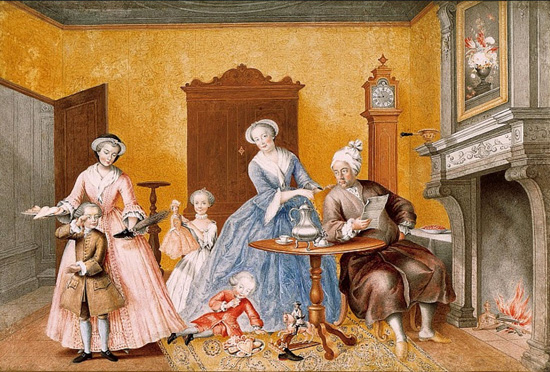Manners, Customs, Clothing
 |
 |
 |
 |
 |
 |
 |
Intimacy & Distinction in the Austrian
Imperial Family Life

Painting depicting Empress Maria Theresa (1717-1780), Archduchess of the House of Austria, married to Francis I (1708-1765), House of Lorraine, Emperor of the Holy Roman German Empire, and their children.
One notes that the children are playing: The young girl has a doll in her hand; one of the boys is on the floor with several toys in front of him. Another boy is standing a short distance away.
The furniture is of very fine quality. As for the carpet, one perceives that it is good Persian rug. On the wall is a painting of a good level and there is a fireplace of some grandeur. There is not a lot of furniture; it is evidently an intimate family room.
Emperor Francis is in slippers wearing a robe de chambre and a night cap, since the winter in Europe is very harsh. Empress Maria Teresa is dressed in a simple outfit.
In their position as the Emperor and the Empress, what shines through in this scene is the Viennese bonomia. He has the way of being of an ordinary man of the bourgeoisie despite being the head of the House of Lorraine and Emperor of the Holy Empire. If she were to go out on the street as she appears in the painting, she would not attract attention.
The boy, with his hand on his face, is a little embarrassed; it appears that he was reprimanded. The Emperor is reading something the child wrote and there is some tension between the two. The Emperor appears to be taking a father's stern attitude towards his son. The eldest sister at left is supporting her brother.
The clothing of the personages in the picture favors a simple naturalness, repose and, unpretentiousness, manifesting the pleasure of family intimacy, which is obviously necessary for the equilibrium of every human spirit. Without the pleasure of intimacy, this equilibrium does not exist. It is not, however, a vulgar intimacy.
It is striking how the children of that epoch dressed. They are clothed like adults; children's clothing was not used. A boy became accustomed from his early years to dress like a little man and to want to be like a man.
Observe the girl holding the doll: She is dressed in a full long skirt. There is essentially no difference between her dress and that of her mother or that of her sister.
Nonetheless, the sense of propriety is still present. The Empress is dressed as befits a young married lady. The princess is wearing a rose colored outfit that would not be suiting for the Empress. The whole sense of proportion is maintained. The atmosphere presents a mixture of bourgeois and aristocratic, but without disharmony.
What we glimpse here is the pleasure of intimacy in the joy of a distinguished family life where manners are preserved.

Excerpt from a lecture by Prof. Plinio of June 25, 1970
Posted June 15, 2018
______________________
______________________








